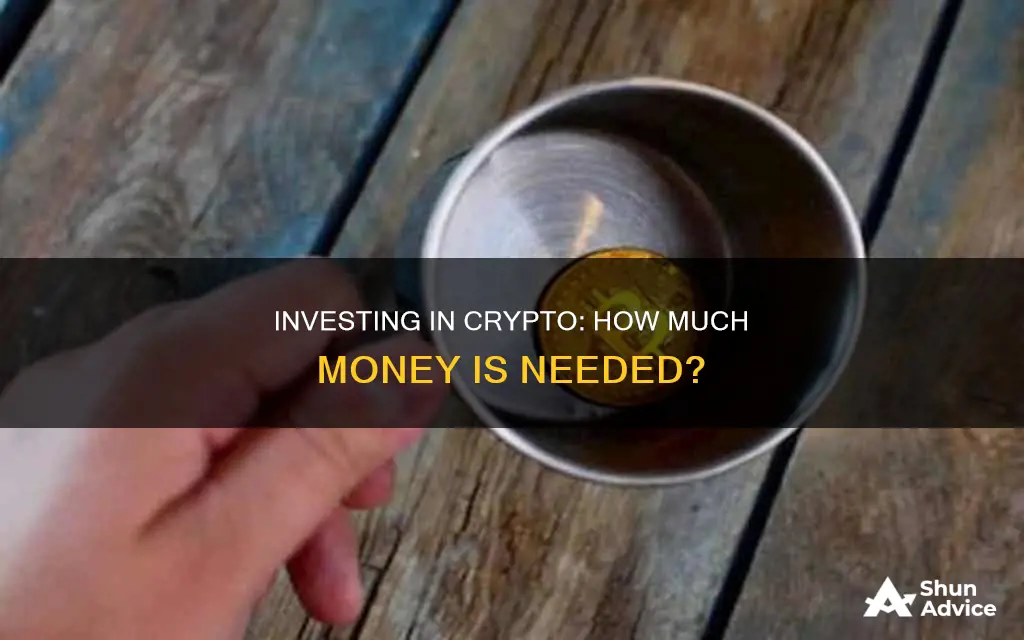
Investing in cryptocurrency is a risky business, and it's important to know what you're doing before you part with your money. The most important rule is never to invest more than you can afford to lose.
Cryptocurrency is a volatile asset class, and its value can go up or down very quickly. It's also a relatively new form of investment, so it's hard to know where the market is headed.
If you do decide to invest, most experts recommend that you allocate no more than 5% of your portfolio to crypto. This is enough to gain exposure to potential gains while limiting the impact of losses.
It's also a good idea to stick to the major cryptocurrencies, such as Bitcoin and Ethereum, which have weathered several market cycles and downturns.
Before investing, be sure to do your research and understand the technology behind crypto.
| Characteristics | Values |
|---|---|
| How much to invest | Most financial experts recommend limiting crypto exposure to less than 5% of your total portfolio. Crypto is considered a high-risk asset class. |
| How much is too much | Only risk capital that you can afford to lose should be exposed to crypto price swings. |
| How much is too little | It takes only a few dollars to invest in cryptocurrency. Most crypto exchanges have a minimum trade of $5 or $10. |
| How much to invest for dollar-cost averaging | Figure out the level of disposable income available at the end of each month. |
| How much to invest based on risk appetite | Evaluate how much risk you feel comfortable taking before investing in cryptocurrency. |
| How much to invest based on age | Seasoned investors advise investing in higher-risk markets when time is on the investor's side. |
What You'll Learn

How much can I afford to lose?
The most important rule when investing in crypto is to never invest more than you can afford to lose. This is age-old advice that is particularly fitting in the cryptocurrency space, where assets are extremely volatile and can gain or lose significant value in a single day.
Before investing, it is crucial to assess how much money you can realistically afford to lose. This means considering your financial goals, timing window, and risk appetite. Ask yourself: how much money are you comfortable with investing? How much money are you comfortable losing? Do you have the stomach to watch the crypto market rise and fall, sometimes as much as 30% in a day?
It is also important to ensure you have enough emergency savings before putting any funds into crypto. Once you're ready to invest, it is recommended that crypto makes up no more than 5% of your portfolio. This is enough to gain exposure to potential gains while limiting the impact of losses.
Additionally, consider your disposable income and how much money you can realistically put aside each month. This will enable you to build your crypto investment over time through dollar-cost averaging, which is a more risk-averse strategy in the long run.
Remember, crypto is a high-risk, volatile investment. By only investing what you can afford to lose, you can navigate this choppy market with a safer approach.
CFX Coin: A Smart Investment Decision?
You may want to see also

What is my risk tolerance?
When determining your risk tolerance, it's important to carefully consider various factors that influence your propensity to take risks. Here are some key aspects to think about:
Investment Goals and Time Frame
Understanding your investment objectives and time horizon is crucial. If you're investing for the long term, you may have more flexibility to take on riskier assets. However, if you need the funds in the short term, it's generally advisable to adopt a more conservative approach to avoid potential losses.
Net Worth and Risk Capital
Your net worth, calculated as your assets minus liabilities, plays a role in determining your risk tolerance. Individuals with a higher net worth and more liquid capital can typically afford to take on more risk. Additionally, consider the amount of risk capital you have—money that you can invest or trade without compromising your lifestyle if lost.
Investment Experience
Your level of experience in investing and trading is another factor. If you're new to the world of investing, it's generally wise to proceed with caution and gain experience before committing substantial capital.
Age and Risk Tolerance Clichés
While age is often associated with risk tolerance, it's not the sole determining factor. Younger investors are typically viewed as having a longer time horizon and, therefore, greater risk tolerance. However, people are living longer, and older individuals may still have a long investment horizon and the capacity to be aggressive investors.
Priorities and Realism
Consider your priorities in terms of what you're saving and investing for, and be realistic about your investment experience. Don't fall into the trap of assuming that just because you can make riskier bets, you should. Preservation of capital is essential, especially if you're new to investing.
Diversification and Risk Management
Even if you have a high-risk tolerance, spreading your investments across different assets or trades can help reduce your overall exposure. Diversification is a crucial aspect of managing risk and preserving your capital.
In conclusion, determining your risk tolerance involves a comprehensive analysis of your financial situation, goals, and comfort with taking on risk. It's a complex process that will help guide your investment decisions and prevent financial ruin.
Green Bitcoin: A Smart Investment Move?
You may want to see also

How much disposable income do I have?
When deciding how much to invest in cryptocurrency, it is important to consider your disposable income. This is the amount of money you have left after paying taxes and other mandatory charges. Disposable income is different from discretionary income, which is the money left over after all necessary expenses, such as rent and groceries, have been paid.
Disposable income can be calculated using the following formula:
Disposable Income = Total Income - Taxes - Mandatory Deductions
Your disposable income will depend on your salary, state, and filing status. It is important to note that disposable income can vary from month to month, as expenses may change. It is recommended to put money into savings before spending your disposable income.
When investing in cryptocurrency, it is generally advised to invest only what you can afford to lose. Most financial experts recommend limiting your crypto investment to less than 5% of your total portfolio. This helps to manage overall volatility and risk.
Therefore, when deciding how much to invest in cryptocurrency, consider your disposable income, risk tolerance, and financial goals. Evaluate how much money you can realistically afford to lose and how much risk you are comfortable taking. Additionally, consider the length of time you are willing to hold your investment, as the cryptocurrency market can be volatile and it may take time to see a return on your investment.
The Dogecoin Investment: How Much Did You Risk?
You may want to see also

How long can I afford to wait for a return?
The length of time you can afford to wait for a return on your crypto investment will depend on several factors, including your financial goals, risk appetite, and investment strategy. Here are some key considerations to help you determine how long you can afford to wait:
- Financial Goals: Ask yourself what you want to achieve with your crypto investment. Are you saving for a short-term goal, such as a down payment on a car, or are you investing for the long term, such as for retirement? If you have short-term goals, you may not be able to wait as long for a return on your investment.
- Risk Appetite: Investing in cryptocurrency carries a high level of risk due to its volatility. You need to assess your risk tolerance and determine how comfortable you are with the potential for significant gains or losses. If you have a low-risk appetite, you may want to consider investing in more stable and traditional assets.
- Investment Strategy: There are different strategies you can employ when investing in crypto. Some popular approaches include dollar-cost averaging, where you invest a fixed amount at regular intervals, or investing in a diverse range of cryptocurrencies to mitigate risk. Your investment strategy will impact how long you can afford to wait for a return.
- Market Conditions: The cryptocurrency market is highly volatile, and its performance can vary over time. Consider the current market conditions and trends when deciding how long to invest. For example, if the market is in a bull run, you may be able to realise gains sooner, whereas a bear market may require a longer holding period.
- Opportunity Cost: Investing in crypto means tying up your capital, which could otherwise be used for other investment opportunities or expenses. Consider the potential opportunity cost of investing in crypto and whether you can afford to have your capital tied up for an extended period.
- Reinvestment Strategy: If you plan to reinvest your crypto earnings, you may need to wait longer to see a return on your initial investment. Evaluate your options for reinvesting your profits, such as in other crypto projects, rental properties, dividend stocks, or simply holding your crypto for the long term.
In summary, there is no one-size-fits-all answer to how long you can afford to wait for a return on your crypto investment. It depends on your individual financial situation, risk tolerance, investment strategy, and market conditions. Always remember to invest wisely, do your research, and never invest more than you can afford to lose.
Smart Ways to Invest $1000 in Bitcoin
You may want to see also

What are the best crypto projects to invest in?
The amount of money one should invest in crypto depends on several factors, including financial goals, timing window, and risk appetite. It is generally recommended not to invest more than one can afford to lose, and common investment advice suggests allocating between 1% and 5% of one's portfolio to crypto, recognising it as a high-risk asset class.
When deciding which crypto projects to invest in, it is important to consider factors such as market capitalization, availability on major exchanges, sector leadership, tokenomics, and the project's technology and development team. Here are some of the top crypto projects to consider as of September 2024:
- Toncoin (TON): A blockchain project closely integrated with Telegram, offering smart contracts functionality and a Proof-of-Stake consensus mechanism.
- NEAR Protocol (NEAR): A layer 1 blockchain designed for web3 adoption, featuring sharding integration and a Proof-of-Stake consensus algorithm.
- Aptos (APT): A highly scalable layer 1 blockchain that supports smart contracts written in the Move programming language.
- Bitcoin (BTC): The original cryptocurrency and a decentralised peer-to-peer digital currency with strong security and a robust blockchain.
- Uniswap (UNI): A decentralised cryptocurrency exchange that introduced the AMM model, allowing direct token swaps on the blockchain without intermediaries.
- Ethereum (ETH): A blockchain platform that supports smart contracts and complex use cases such as decentralised lending and non-fungible tokens (NFTs).
- Solana (SOL): A high-performance smart contracts platform with a unique architecture that enables fast and low-cost transactions.
- XRP (XRP): A fast and efficient digital currency developed by Ripple, suitable for remittances and cross-border money transfers.
- Kaspa (KAS): A decentralised cryptocurrency project focused on scalability and fast transactions, utilising a blockDAG and a proof-of-work consensus mechanism.
- Binance Coin (BNB): The native token of the Binance cryptocurrency exchange, offering benefits such as reduced trading fees and access to exclusive programmes.
- Maker (MKR): A decentralised finance protocol on Ethereum that issues and manages Dai, a decentralised stablecoin pegged to the US dollar.
- Arbitrum (ARB): A layer 2 scalability solution for Ethereum, providing faster and cheaper transactions while maintaining the security of the Ethereum network.
Cryptocurrency Investing: Taxable or Tax-Free?
You may want to see also







